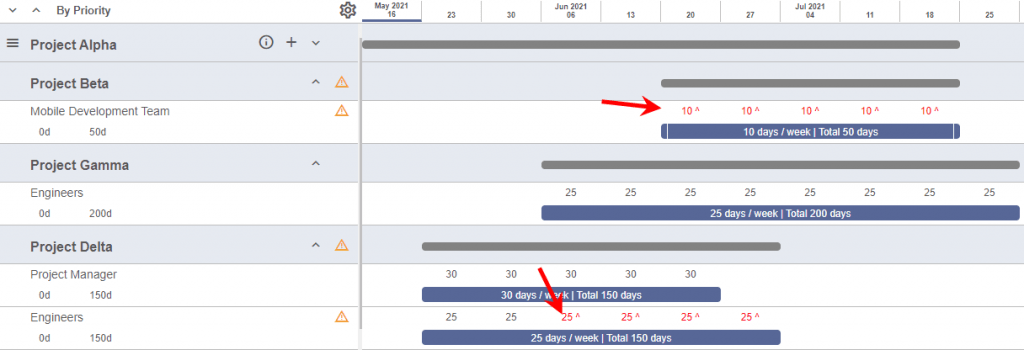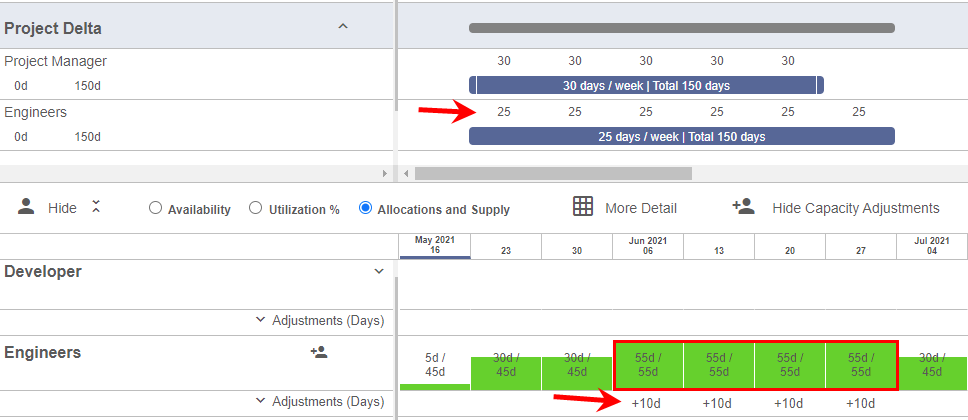
Ultimate Guide to Resource Capacity Planning
Resource capacity planning can be a tricky puzzle to crack but that is no reason to ignore it. I have spent many years working with different organizations over a range of industries to help them work it out.
Now I am sharing with you a host of tactics, best practice and tips to help you make the most of your resources.
Chapters
Trying to create a resource capacity plan is enough to stop most resource and project managers dead in their tracks.
If this sounds like you don’t worry.
Even if you have never created a resource capacity plan before, I am going to walk you through the process step by step.
And the capacity planning process I explain works whether you run agile projects or traditional waterfall projects.
It is a proven process that I have used with many organizations over the years and I am going to share it with you.
Let’s take a closer look.
Click here if you want to jump straight into the details of how to do resource capacity planning. With worked examples, screenshots and more.
What is resource capacity planning?
Resource capacity planning compares the resources you have to the resources you need to get the projects you want to do done.
A resource capacity plan compares the capacity of your resources (i.e. the people and skills you have available to work on projects) with the amount of work and skills the projects need.
It helps you understand things such as:
- Will you have enough resources to do the projects you want to do?
- Do you need to hire more resources (or conversely do you have too many resources)?
- Is the mix of skills you have appropriate for the work you want to do?
But there is more.
A capacity plan is also a decision support tool for your projects and resources.
What do I mean by this?
- Resource capacity planning is a process that seeks the best outcomes for your projects and resources.
- You can’t do every project you are asked to do and you can’t hire unlimited resources.
- So you need to make trade-offs and difficult decisions about what you can and can’t do.
So a resource capacity plan is also a toolbox that helps you make decisions such as:
- What if we hire another 5 engineers in May?
- How will things look if we take on another 3 projects in Q4?
- Can we re-allocate people from Project Alpha to Project Beta and still get both done on time?
Do you get the idea?
Resource capacity planning can be done standalone, but it often forms part of the portfolio management process. Decisions about what projects you can approve are influenced by your available resource capacity.
While many folks try to build capacity plans in spreadsheets or resource scheduling tools, it is this last piece of the jigsaw (the decision support) that they can’t successfully support.
So we recommend you take a look at the resource management software available. A small investment in the right tool pays for itself many times over.
If you are unsure if you need to implement capacity planning, you can always read about the benefits.
And an important point before we move on
The terms capacity planning and resource planning are often used interchangeably.
However, they are different processes with different outputs.
- Capacity planning is concerned with balancing resource levels and making decisions about what projects you can do over the next 3 to 6 to 12 months.
- Resource planning is concerned with which resources to allocate to which projects over the coming month or two.
Ultimate Guide to Resource Capacity Planning
Chapter 2
Resource capacity planning process
Now I will walk you through the steps involved in building a resource capacity plan.
To help explain the concepts I will use some screenshots from the Kelloo resource management tool.
In this section
Resource Capacity – understand the resources and skills you have
Resource Demand – understand the labour needs of your projects
Compare Capacity vs Demand – check the gaps between your resource capacity and resource needs
What If Planning – evaluate different project timings or hiring plans to close capacity gaps
Resource capacity
Calculate your resource capacity
Obvious as it sounds, the first step in the resource capacity planning process is to calculate your resource capacity.
- Start by creating an inventory of all the resources you have available to you (this is sometimes called a resource pool).
- And for each resource work out how much labor time they provide to you (this can be in hours or days).
Don’t forget people also have vacations, sickness and other absences which further reduces their available time. Plus they spend time grabbing a coffee and chatting around the water cooler. So don’t plan on getting 100% of a resources time actually spent on productive hours.
So your resource capacity calculation should look something like this:
Resource capacity = contracted working hours – sickness – vacations – other absences – overheads
You obviously can’t predict how many hours people will be off sick, on vacation etc. So you use estimates for this based on historic trends.
Here is how the resource pool in Kelloo looks.

Summarize your capacity into skills or teams
Capacity planning is not done at the level of individual resources.
Instead, it is done at the level of teams or skills.
So the next step is to summarize your resource capacity into teams or skills and total this per period.
We think weekly or monthly works best.
So for each skill or team, you now understand how many days capacity they can provide you for work.
To understand this a little better take a look at how it looks in Kelloo. You can now see each team and skill and their capacity per period.

Resource demand
Understand what projects and work you want to do
Next figure out what work you want to do.
Most folks organize their work into projects so let’s stick with that name for now.
So pull together a list of your projects, both current AND future projects you want to do.

Prioritize your projects and work
Now organize your work into priority order.
This is such an important step but often overlooked.
The reason you prioritize work is that you are going to have to make decisions about what work does not get done or gets pushed out in time.
So it makes sense that you try to do the highest priority work first.
If you know the work needs to happen through any particular time, schedule it to where it needs to go.
This is how the prioritized list of projects appears in Kelloo.

Estimate your work and assign teams or skills
Next put in estimates for the amount of work involved and the types of resources needed.
In the example below we have just estimated the work on Project Beta will take the Mobile Development Team 50 days over 5 weeks.

And we continue doing this for each project.
Just so you understand, the numbers above the purple bars are how many days per week the resources have been estimated to spend on each project.
Click on the images to view a larger version.
Compare your capacity to your demand
Check if you have sufficient resource
Now you need to do a gap analysis between your project demand (the work you want to do) and your resource capacity (the supply of your resources).
The easiest way to view this is on a resource heat map.
Here is the resource heat map in Kelloo. The cell colors and fill levels indicate relative levels of capacity vs supply.
Red is bad, green is good!
If we zero in on the heat map we can see straight away that both our Engineering group and Mobile Development Team don’t have enough capacity to do the projects as we have planned them.
The Engineering group is allocated 55 days per week when they only have a capacity of 45 days.
And the Mobile Team is allocated 30 days per week compared to their capacity of 25 days.
Big problem.
But on the plus side, the project manager group have too little work!
However, we are missing an important piece of the jigsaw here.
We know our resources are over-allocated, but which projects will this impact and when?
Now take a look at the purple bars in the planner because they tell us something very important.
Not only when the work is planned to happen.
But also when each project will run out of resource.
If we see red numbers the project is short of resource.
Project Beta does not even get out of the blocks. It is short of resource from week 1.
Whereas Project Delta is ok for Project Managers but has a shortfall of Engineers from week 3.
What if scenario planning
Analyze and resolve your resource capacity issues
Ok, so you have problems. Now what?
Well, the next step is to get a balanced capacity plan.
This means a plan where the demands on your resources do not exceed the capacity (or supply) of your resources.
You can do this by adjusting the resource demand, the resource capacity or more likely a mix of both.
Here are some of the things you can change to affect the demands on your resources:
- Re-scheduling when work is happening.
- Deferring or cancelling lower priority work.
- Re-prioritize work.
And here are some of the things you can change to affect your resource supply:
- Hiring more people.
- Re-allocating resource from lower priority projects.

Following on from our example above, we have a shortfall of capacity in the Engineer group and the Mobile Development Team.
The first thing we try is to model the effect of hiring more people into the Engineer group which adds an extra 10 days capacity.
And we find that hiring just another two engineers will resolve the capacity issue for the Engineer group.
With the Mobile Development Team we take a different approach by pushing the work out to start later in the year freeing up the resource capacity for other projects.
These simple changes have resolved the resource capacity issues in the plan.
Test different plan options using scenarios
When capacity planning there is no “right” answer.
Instead, you need to test out different options and solutions to see which works best.
You can do this in Kelloo using scenarios.
Scenarios are versions of a resource plan that can be independently adjusted and then compared to each other.
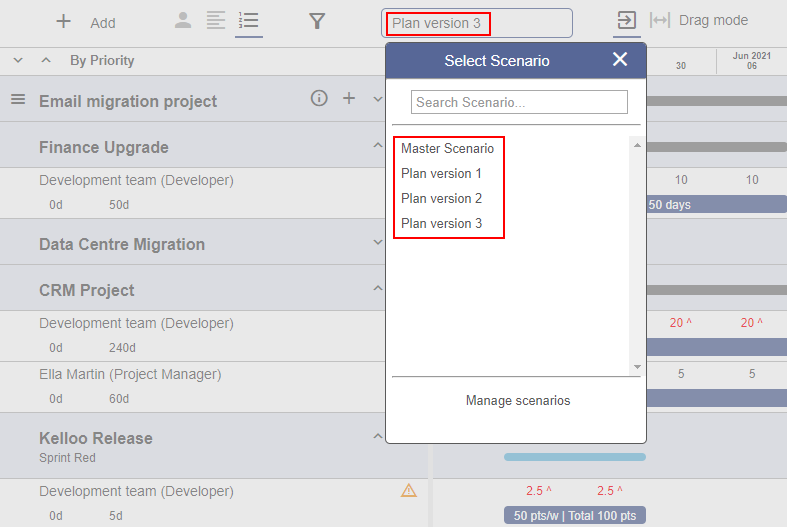
Try Kelloo with your team
Plan, forecast and deliver smarter. We help you get the most from your projects and people.
Ultimate Guide to Resource Capacity Planning
Chapter 3
Resource capacity planning best practice
So you are sold on the idea of implementing a capacity planning process.
The thing is, setting up a resource capacity planning process can see a little overwhelming.
So the best approach is to break it into baby steps and focus on areas that will give you the most value fast.
When we work with customers, we tell them to focus on these key resource capacity planning best practices:
- Don’t get too detailed. A high level plan will get you 90% of the benefits in 10% of the time.
- A capacity plan needs to include all the demands made on your resources. So ensure you account for all work including BAU.
- Don’t forget to account for holidays, vacations and absences when calculating capacity. The best approach is to use a trend rather than try to track individual absences.
- Don’t try to plan too far into the future. A capacity plan looking from 3 to 6 months into the future is a good starting point.
- Plan by role / skill as opposed to individual resources. What is important is the aggregate demands made on your resources and how this compares to your capacity.
Resource capacity planning best practices, tips and strategies is a great resource if you are ready to take a deeper dive into resource capacity planning best practices. You may also want to check our resource capacity planning software buyers guide if you want to look at software solutions.
Ultimate Guide to Resource Capacity Planning
Chapter 4
Benefits of resource capacity planning
Resource capacity planning helps ensure you have enough people with the right skills to work on the projects you want to deliver.
Getting this wrong can be costly and lead to poorly utilized resources and project delays. But organizations in the know have long realized the benefits of taking a proactive approach to managing their resources capacity.
As a manager, do you find yourself agreeing to projects without knowing if you have the resources to finish them? Capacity planning could be the answer.
Here are some of the ways capacity planning can benefit your organization:
1. Transparency
Resource capacity planning gives you improved transparency over your resources capacity, your organizations skills levels and bandwidth for work.
2. Manage unrealistic expectations
You will be better able to demonstrate the current resource capacity of your organization and the number of projects you can realistically deliver given your headcount.
3. Earlier visibility of problems
Resource constraints and hotspots will be identified earlier meaning corrective action can be taken before they impact schedules.
4. Compare resource and project options
What if analysis can be used to compare how different project timings, schedules and resource levels play out against each other. Sometimes called what if analysis.
5. Better decisions on how resources are used
With clear visibility into resources shortfalls, you can better evaluate whether you need to hire resources or can re-deploy resources from lower priority projects.
Resource capacity planning benefits and why you need to get it right is a great resources if you want a deeper dive into this topic.
Ultimate Guide to Resource Capacity Planning
Chapter 5
Agile resource capacity planning
If you run agile projects and think resource capacity planning does not apply to you, you are wrong.
And here is why. Organizations have a pretty fixed amount of people (their supply).
However, they will have an almost unlimited amount of things they want to do (their demand). And demand will almost certainly exceed supply.
So organizations are faced with decisions – what projects and work should they do now and what gets dropped or pushed into next year.
And these decisions need to be made however you choose to run your projects.
And this is what capacity planning gives you – a way to evaluate different selections of projects, resource hiring levels and resource allocation plans until you find something that works for you.
If you are looking for guidance on sprint capacity planning, our article agile sprint capacity planning is a great place to start.
Below we outline how the agile resource capacity planning process works. And for a deeper dive we recommend looking at agile resource planning – the definitive guide.
1. Work out your resource capacity
Work out the total amount of days your people can work excluding things like vacation. Total by team / skill.
2. Plan your sprints keeping an eye on capacity
Allocate people (or teams) to sprints. For each sprint you can now work out the sprint capacity (how much work can be done in the sprint) based on the people allocated and their capacity. Finally allocate work to the sprint making sure not to exceed the sprint capacity.
3. Plan your projects and other activities
The chances are your people won’t be just working on sprints. So included in your capacity plan all the other things they need to do (non agile projects, business as usual activities etc).
4. Check your resource capacity
You should now have a good idea of all the demands being made on your people. So compare the total demand to the capacity calculated earlier. If demand exceeded capacity you need to look at deferring work, re-allocating work or perhaps hiring more people.
5. Forecast future resource needs
Capacity planning needs to look further than the next sprint or two. So ensure you put high level forecasts in your plan for upcoming work (perhaps out as far as 6 months).
We do this so we can make longer term commitments as to what projects we aim to work on, tentative delivery dates and formulate hiring plans.
These forecasts can use things like roadmaps, work backlogs and up-approved projects to give you an idea of future work.
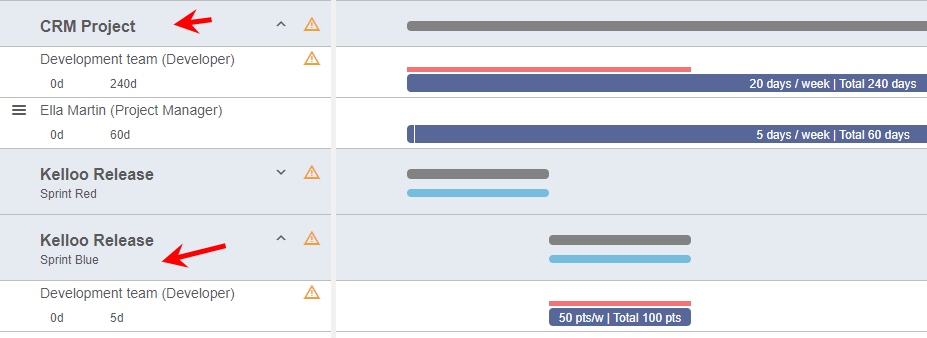
Ultimate Guide to Resource Capacity Planning
Chapter 6
Resource capacity planning software
Most organizations start by using spreadsheets for resource capacity planning but soon realize they are not a great solution for capacity planning. A better option is often to implement resource capacity planning software.
What does resource capacity planning software do?
With resource capacity planning software you can:
- Understand the resource capacity of your organization.
- Get a handle on the skills mix in your organization.
- Compare this to the resource demand coming from your projects and spot resource gaps.
- Make better informed resourcing decisions.
This allows you to identify resource shortfalls, and make decisions about which projects you can do and how best to allocate your resources to projects.
Our post choosing resource capacity planning software is a great place to start if you are considering implementing a software solution for capacity planning.
Resource capacity planning software - 5 key features
Here are some of the must have features you should look for when comparing resource capacity planning software.
1. Role and team based planning
Being able to capacity plan resource by role (skill) or team is essential.
Don’t choose resource management software that forces you to do your planning at the named resource level.
2. Agile and waterfall
Look for resource capacity planning software that supports both agile and waterfall planning techniques.
And remember, not all work an organization does is projects.
So check the software can also be used to plan the other non-project work your resources do.
A Kelloo resource plan can contain a mix of agile and traditionally planned work alongside general business activities meaning your resource management picture is complete.
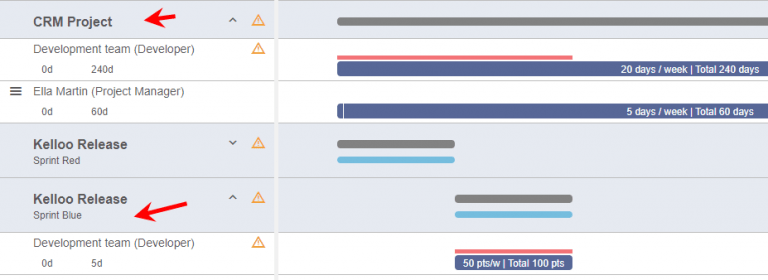
3. Scenario planning
There is no right answer when doing resource management.
Instead, there are competing resource and project options that need to be evaluated against each other to strike the best balance.
This is called scenario planning or what if modelling.
It lets you see how approving a new project, hiring more resource or cancelling a project would impact your current schedule and resource utilization.
So ensure any resource management software you select allows you to create different planning scenarios.
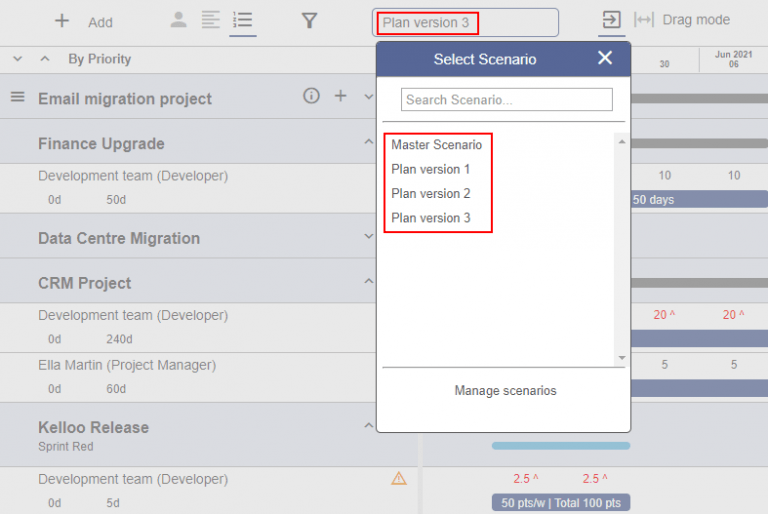
4. Utilization reporting
Resource utilization is a metric that shows you how busy resources are.
And conversely, it can also show you how available your resources are.
Resource utilization reporting is an essential component of resource management software which shows you which resources are in short supply or have the capacity to take on more work.
5. Remember the money - finance tracking
While resource capacity and utilization levels are key metrics, capacity planning software also needs to focus on resource costs.
Decisions on allocating resources will often be constrained by financial considerations.
So look for software that lets you allocate usage costs to resources and then shows you how your resource plans stack up in terms of money.
Resource capacity planning spreadsheet
A spreadsheet is normally the first tool that organizations turn to when trying to move their resource capacity planning into a software solution.
Spreadsheets are easy to use and most organizations have a copy of Excel, Google Sheets or some other spreadsheet tool.
But here is the deal. If you are capacity planning a handful of resources and projects you may just get away with using a spreadsheet.
However, as the number of projects and resources increases you should look to implement dedicated resource capacity planning software.
Here are some of the reasons we think using a spreadsheet for resource capacity planning may not be the best way to manage your capacity planning process.
1. Cell based editing
Moving or rescheduling work in your resource plan will require editing lots of cells. Which is time consuming and error prone.
With a tool like Kelloo, planning and rescheduling work is accomplished by just dragging bars. The capacity and utilization will automatically be re-calculated for you.
2. Lack of inbuilt reporting
Spreadsheets do not include any standard reporting capability and reporting is a major need in resource capacity planning software.
3. Complicated formulas are error prone
The formulas required to build a capacity planning spreadsheet are pretty complicated. Which makes it easy for errors and bugs to creep in.
A single error in a formula and your capacity plan could be way off track.
4. No capacity planning features out of the box
Using a spreadsheet will mean building and developing the solution from scratch and trying to implement features that are standard in resource capacity planning software.
5. Require macros and programming
Spreadsheet formulas will never be enough to implement a workable capacity planning solution. So inevitably you will have to use macros or program the spreadsheet to work like an application.




